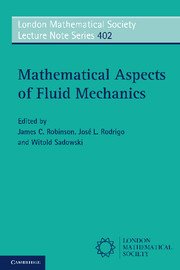Book contents
- Frontmatter
- Contents
- Preface
- List of Contributors
- 1 Towards fluid equations by approximate deconvolution models
- 2 On flows of fluids described by an implicit constitutive equation characterized by a maximal monotone graph
- 3 A continuous model for turbulent energy cascade
- 4 Remarks on complex fluid models
- 5 A naive parametrization for the vortex-sheet problem
- 6 Sharp and almost-sharp fronts for the SQG equation
- 7 Feedback stabilization for the Navier–Stokes equations: theory and calculations
- 8 Interacting vortex pairs in inviscid and viscous planar flows
- 9 Stretching and folding diagnostics in solutions three-dimensional Euler and Navier–Stokes equations
- 10 Exploring symmetry plane conditions in numerical Euler solutions
- 11 On the decay of solutions of the Navier–Stokes system with potential forces
- 12 Leray–Hopf solutions to Navier–Stokes equations with weakly converging initial data
- References
8 - Interacting vortex pairs in inviscid and viscous planar flows
Published online by Cambridge University Press: 05 November 2012
- Frontmatter
- Contents
- Preface
- List of Contributors
- 1 Towards fluid equations by approximate deconvolution models
- 2 On flows of fluids described by an implicit constitutive equation characterized by a maximal monotone graph
- 3 A continuous model for turbulent energy cascade
- 4 Remarks on complex fluid models
- 5 A naive parametrization for the vortex-sheet problem
- 6 Sharp and almost-sharp fronts for the SQG equation
- 7 Feedback stabilization for the Navier–Stokes equations: theory and calculations
- 8 Interacting vortex pairs in inviscid and viscous planar flows
- 9 Stretching and folding diagnostics in solutions three-dimensional Euler and Navier–Stokes equations
- 10 Exploring symmetry plane conditions in numerical Euler solutions
- 11 On the decay of solutions of the Navier–Stokes system with potential forces
- 12 Leray–Hopf solutions to Navier–Stokes equations with weakly converging initial data
- References
Summary
Abstract The aim of this contribution is to make a connection between two recent results concerning the dynamics of vortices in incompressible planar flows. The first one is an asymptotic expansion, in the vanishing viscosity limit, of the solution of the two dimensional Navier-Stokes equation with point vortices as initial data. In such a situation it is known, see Gallay (Arch. Ration. Mech. Anal.200 (2011) 445–490), that the solution behaves to leading order like a linear superposition of Oseen vortices whose centres evolve according to the point vortex system. However, higher order corrections can also be computed and these describe the deformation of the vortex cores due to mutual interactions. The second result is the construction by Smets & Van Schaftingen (Arch. Ration. Mech. Anal.198 (2010) 869–925) of “desingularized” solutions of the two-dimensional Euler equation. These solutions are stationary in a uniformly rotating or translating frame, and converge either to a single vortex or to a vortex pair as the size parameter ∈ goes to zero. We consider here the particular case of a pair of identical vortices, and we show that the solution of the weakly viscous Navier-Stokes equation is accurately described at time t by an approximate steady state of the rotating Euler equation which is a desingularized solution in the sense of Smets & Van Schaftingen (2010) with Gaussian profile and size
Introduction
Numerical simulations of freely decaying turbulence show that vortex interactions play a crucial role in the dynamics of two-dimensional viscous flows, see McWilliams (1984, 1990).
- Type
- Chapter
- Information
- Mathematical Aspects of Fluid Mechanics , pp. 173 - 200Publisher: Cambridge University PressPrint publication year: 2012
References
- 3
- Cited by

